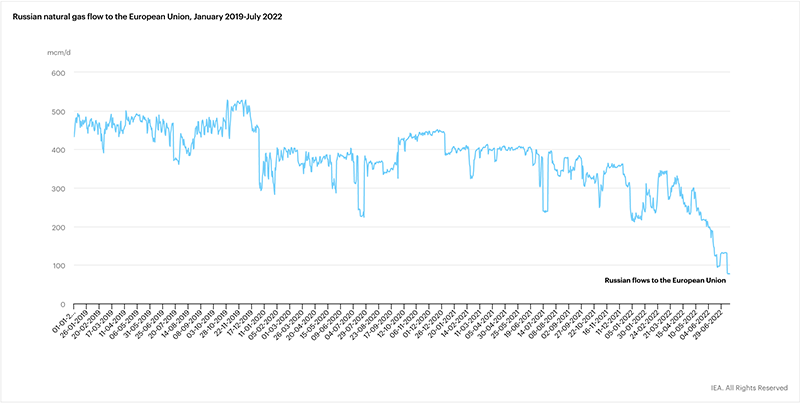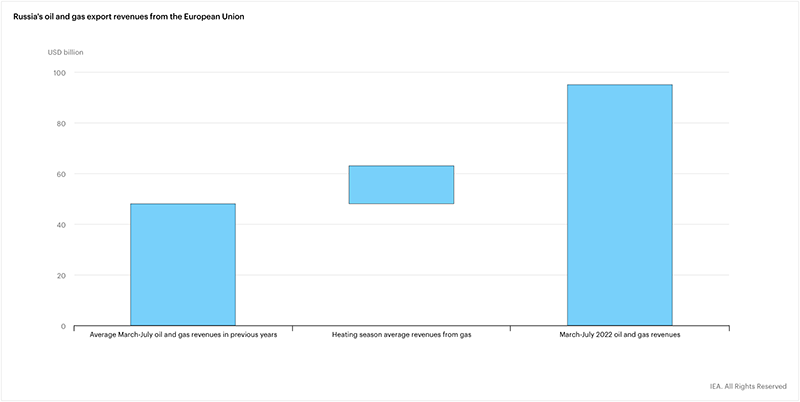
This article was published by the International Energy Agency on July 18, 2022.
Dr Fatih Birol, Executive Director, International Energy Agency
The world is experiencing the first truly global energy crisis in history. And as the International Energy Agency has been warning for many months, the situation is especially perilous in Europe, which is at the epicentre of the energy market turmoil. I’m particularly concerned about the months ahead.
The gas crisis in Europe has been building for a while, and Russia’s role in it has been clear from the beginning. In September 2021 – five months before Russia’s invasion of Ukraine – the IEA pointed out that Russia was preventing a significant amount of gas from reaching Europe. We raised the alarm further in January, highlighting how Russia’s large and unjustified reductions in supplies to Europe were creating “artificial tightness in markets” and driving up prices at exactly the same time as tensions were rising over Ukraine.
After Russia invaded Ukraine on 24 February, nobody in Europe or elsewhere could be under any illusions about the risks around Russian energy supplies. Just a week after the invasion started, the IEA released our 10-Point Plan to Reduce the European Union’s Reliance on Russian Natural Gas, setting out the practical actions Europe could take. It stressed the need to maximize gas supplies from other sources; accelerate the deployment of solar and wind; make the most of existing low emissions energy sources, such as renewables and nuclear; ramp up energy efficiency measures in homes and businesses; and take steps to save energy by turning down the thermostat.

Coordinated actions across Europe are essential to prevent a major gas crunch: Here are 5 immediate measures
Sources
IEA analysis based on ENTSOG (2022), Transparency Platform. To see an animated version of this graph, click here.
The message was clear: with early and sustained action, it would be possible to reduce the EU’s reliance on Russian gas imports by one-third within a year – and to do so in an orderly manner that would be consistent with the EU’s climate ambitions.
We have seen some progress on this, particularly in terms of diversifying gas supplies – but not enough, especially on the demand side, to prevent Europe from finding itself in an incredibly precarious situation today. Russia’s latest moves to squeeze natural gas flows to Europe even further, combined with other recent supply disruptions, are a red alert for the European Union. As we get closer to next winter, we are getting a clearer sense of what Russia may do next. The next few months will be critical.
In my conversations with European leaders, including at the G7 Summit in Elmau, Germany, and in a meeting last week with European Commission President Ursula von der Leyen and all the EU Commissioners, I have been urging them to do all they can right now to prepare for a long, hard winter. It is encouraging to see the readiness of key European leaders to be proactive on this issue. It will require strong resolve and determination to see it through.
What options are available to Europe today, assuming Russia maintains some gas supplies over summer?
Europe is now forced to operate in a constant state of uncertainty over Russian gas supplies, and we can’t rule out a complete cut-off. In my view, it is much better to take steps now to prepare for winter than to leave the well-being of hundreds of millions of people and European economies at the mercy of the weather or, even worse, to give unnecessary extra leverage to President Vladimir Putin of Russia.
At this moment, flows have been halted through Nord Stream, the biggest single gas pipeline between Russia and Europe, for what Russia says is planned maintenance that is due to end on 21 July. Russia had already significantly reduced the flows coming through Nord Stream in June, and it remains unclear whether they will resume and if so, at what level, after 21 July.
To understand the challenge Europe faces, let’s consider a scenario in which gas flows through Nord Stream return after 21 July to the low levels they were at before the current halt – but at the start of the winter heating season on 1 October, Russian gas supplies to Europe are cut off completely. In this situation, the EU would need to have filled its gas storage facilities to above 90 per cent of their capacity by then to get through the coming winter. And even then, it could still face supply disruptions in the latter part of the heating season.

Achieving that 90 per cent storage level is still possible, but Europe needs to act now and make every remaining day count.
The first immediate step towards filling European gas storage to adequate levels before winter is to reduce Europe’s current gas consumption, and to put the saved gas into storage. Some of this is happening already because of sky-high gas prices, but more is required. Significant additional reductions are needed to prepare Europe for a tough winter ahead. According to new IEA analysis, the extra gas that needs to be saved over the next three months is in the order of 12 billion cubic metres – enough to fill about 130 LNG tankers.
This is a big ask, but it does not exaggerate the scale of what is needed – or what is possible if the right measures are taken. It is categorically not enough to just rely on gas from non-Russian sources – these supplies are simply not available in the volumes required to substitute for missing deliveries from Russia. This will be the case even if gas supplies from Norway and Azerbaijan flow at maximum capacity, if deliveries from North Africa stay close to last year’s levels, if domestic gas production in Europe continues to follow recent trends, and if inflows of LNG increase at a similar record rate as they did in the first half of this year. That is already a lot of “ifs”, and as mentioned above, this scenario also assumes that Russian gas flows through Nord Stream will resume at the end of the current maintenance period at the same levels as before it.
In this difficult context, I would like to propose five concrete actions that European leaders need to take for a more coordinated, EU-wide approach to prepare for the coming winter.
- Introduce auction platforms to incentivize EU industrial gas users to reduce demand. Industrial gas consumers can offer part of their contracted gas supply as demand reduction products for compensation, which can lead to efficiency gains and a competitive bidding process. We have already seen auction models being developed in Germany and proposed in the Netherlands.
- Minimize gas use in the power sector. This can be done by temporarily increasing coal and oil-fired generation while accelerating deployment of low-carbon sources, including nuclear power where it is politically acceptable and technically feasible.
- Enhance coordination among gas and electricity operators across Europe, including on peak-shaving mechanisms. This can help reduce the impact of lower gas use on power systems. It should include strict cooperation on the operation of thermal power plants at national and European levels.
- Bring down household electricity demand by setting cooling standards and controls. Government and public buildings should take the lead on this to set an example while campaigns should encourage behavioural changes among consumers.
- Harmonize emergency planning across the EU at the national and European level. This should cover measures for supply curtailments and solidarity mechanisms. To get through the current crisis, the EU needs unified action.
If these types of measures are not implemented now, Europe will be in an extremely vulnerable position and could well face much more drastic cuts and curtailments later on.
In addition to the measures above, European governments also need to prepare the people of Europe for what may be coming. Public awareness campaigns in the context of an energy crisis have been successful previously in reducing short-term energy demand by several percent. Every action counts. Simple steps such as turning down the heating by a couple of degrees in Europe can save the same amount of natural gas that is supplied over the winter by the Nord Stream pipeline.
What happens if Russia completely cuts off gas supplies to Europe before winter?
Based on what we have seen over the past year, it would be unwise to exclude the possibility that Russia could decide to forgo the revenue it gets from exporting gas to Europe in order to gain political leverage. It has already capitalized on the current energy crisis to bring in huge amounts of extra money. Since its invasion of Ukraine, the amount of revenue that Russia has collected from exporting oil and gas to Europe has doubled compared with the average of recent years – to $95 billion.
To put it another way, the increase in Russia’s oil and gas export revenues in just the last five months is almost three times what it typically makes from exporting gas to Europe over an entire winter.

Coordinated actions across Europe are essential to prevent a major gas crunch: Here are 5 immediate measures. To see an animated version of this graph, click here.
If Russia decides to completely cut off gas supplies before Europe can get its storage levels up to 90 per cent, the situation will be even more grave and challenging. It will require cool-headed leadership, careful coordination and a strong degree of solidarity. European leaders need to be preparing for this possibility now to avoid the potential damage that would result from a disjointed and destabilizing response.
Today, Europe needs to do be doing everything it can to reduce the risk of major gas shortages and rationing, especially during the coming winter when its most vulnerable citizens can least afford to go without it. At the same time, it needs to stay the course on its clean energy transition. I look forward to seeing the measures the European Commission will announce on this front later this week.
This winter could become a historic test of European solidarity – one it cannot afford to fail – with implications far beyond the energy sector. Europe may well be called upon to show the true strength of its union.


Be the first to comment